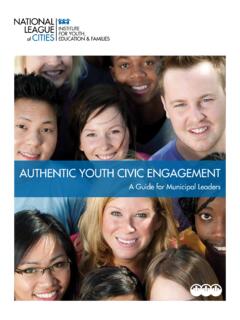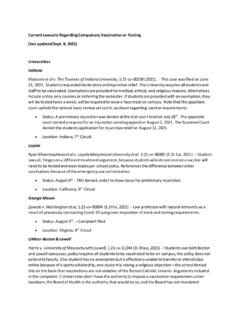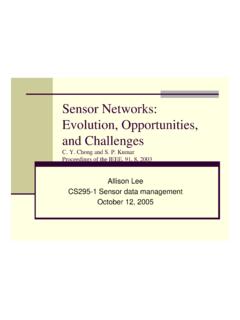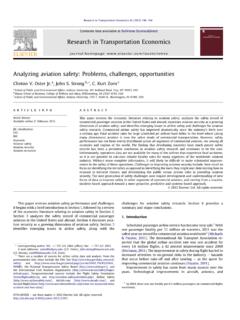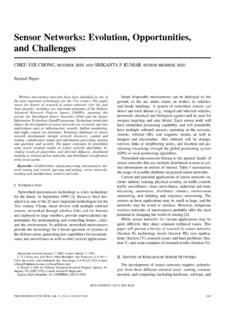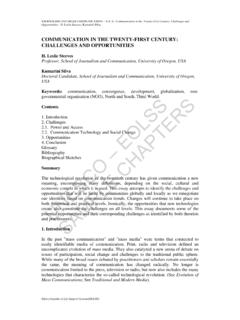Transcription of POLICING IN THE 21ST CENTURY: TRENDS, …
1 JAMES W. BAKERDIRECTOR, LAW ENFORCEMENT OPERATIONS AND SUPPORT, IACPPOLICING IN THE 21 STCENTURY: trends , challenges AND OPPORTUNITIESINTRODUCTIONS/GOALS AND OBJECTIVES Change is Acceleration of change? Continue? Sustainable? What does it look like to you? What is the best approach? Goals: A sense of what is driving this change; accelerators Identify the challenges of this sea change Collectively identify opportunities in these changes Frame the conversations within the framework of Presidents Task Force on 21stCentury POLICING Provide some guidance on how you can respondTHE HISTORY It is important to look at history Law enforcement has gone through significant changes In fact, law enforcement is more adaptable to change than given credit for The history of POLICING has always been based on a struggle over power and trust, starting with our democracy; suspicions of government power? The push for local power over federal power is still rooted in POLICING power today; different expectation locally Early role: Provide order and peacekeeping; act as guardian Early POLICING used shame, disapproval, etc.
2 Where does this play today? community norms? In 1720 NYC population was 7,000 ; a watch man system worked; no need to develop CJ system As population grew the CJ complexity grew The growth of population westward gave rise to sheriffs, posses, etc. In the east, urban areas developed a different model of POLICING In the South, slavery and POLICING were suppressive Communities drove the expectation; different today? 1882-1968approximately 5,000 people of color were lynched What is the tie now? 1900 early innovation-insular 1893 IACP was created, August Vollmer -Social Sciences; First great From the early innovation came UCR Data Collection -IACP Role Then came the era of the FBI and Crime Fighters -J. Edgar Hoover Shift from Social Science to fighting crime -warrior We moved this early from beat cops/close to citizens, to measuring outcomes on activity and arrest Orlando Wilson was prot g of Vollmer We moved to motor cars, radios, prevention/response POLICING was about controlling crime and unrest It was 1967 -the President's Commission on LE and Administration of Justice.
3 This was the last major look at the holistic system What followed was confirmation of Wilson s work and call for service model of POLICING ; led to negative police encounters -SOUND SIMILAR TO WHAT/WHEN? 1970, Kansas City, KS Study re: patrol prevents crime -visibility 1980 -1990s brought us to move away from some of the prior work to an era of community POLICING Creation of the Office of Community Oriented POLICING Services (COPS). 1992, Crime Bill, the complexity of crime came into focus; police were innovating James Wilson, George Kelling, and others -Broken Windows 9/11 -Guardian to Warrior Why? The expectationTHE NEW CROSSROAD POLICING role changed at cost of interaction with citizens Build up Military Equipment It became about the HOMELAND The push for technology from sharing information, to facial recognition The gathering of data from LPR, to surveillance cameras to BWC Police following expectation, Snowden How does Snowden affect your town?
4 Rooted in our history is the inherent mistrust that goes back to our founding fathersNATIONAL CONTEXT Recent events have captured America s attention Recent conversation with David Muir from ABC producers, it is the story of this decade; Ferguson, Baltimore, N. Charleston, , etc. Political atmosphere Police behavior, including bad behavior, in media daily; moved by social media Perception vs. data regardless of historically low rates of use of force, the negative public perception, and mistrust are driving the dialogue Citizen reaction, particularly disenfranchised linked to history of mistrust. Who is this generation? 1968 Calling the question: How strong is your trust relationship with your community? THE RESULT CONFUSED CHALLENGED FRUSTRATED TIRED HOW DO YOU SEE ITPOLICE REFORM MEASURES Democrats, Republicans working together on Colorado police reforms. Five bills would expand: Who is protected by ban on police profiling Require video recording of all interrogations Block "gypsy cops" fired from one agency from keeping that record hidden from future employers Ban police choke holds in most circumstances Expunge the record after a false arrestPRESIDENT OF THE UNITED STATES SPEAKS AT IACP CONFERENCE Office of the Governor, State of VA ICMA Symposium ICMA Annual Conference Utah Chiefs of Police Association Vermont Chiefs Association Wisconsin Police Executive Group Miami-Dade Chiefs of Police Association Delaware Association of Chiefs of Police Kansas Association of Chiefs of Police Michigan State Police Leadership SymposiumTASK FORCE AND DEPARTMENT INVOLVEMENT Encouraging a wellness check Separating the wheat from the chaff what s real?
5 Providing accurate information and assessments Facilitating discussions around a strategyWHY ARE WE DISCISSING THESE MATTERSTHE PROBLEM IN SOME COMMUNITIES Erosion of trust Lack of transparency Lack of legitimacy Disenfranchisement Law enforcement as the face of government Documentation of abuses widely availablePRESIDENT S TASK FORCE ON 21 STCENTURY POLICING The call for a task force was a reaction to recent national events Executive Order 13684 explains that reasoning Strong, balanced leadership and composition Laurie Robinson (GMU) is a co-chair on IACP s Research Advisory Committee Charles Ramsey serves on the IACP Executive Committee representing Cities over 1,000,000 populationTESTIMONY TO THE TASKFORCE Public Listening Sessions/Written Testimony Due diligence done -opinions sought from all aspects of the community IACP had strong presence and influence Radically different perspectives across testifiers? Not All saw opportunities for continuous improvement Many acknowledged common themes regarding police and their community Solutions definite variation how to address the issues effectively across the country is a complex undertakingTASK FORCE INTRODUCTION RECOMMENDATION: The President should support and provide funding for the creation of a National Crime and Justice Task Force to review and evaluate all components of the criminal justice system for the purpose of making recommendations to the country on comprehensive criminal justice reform.
6 RECOMMENDATION: The President should promote programs that take a comprehensive and inclusive look at community based initiatives that address the core issues of poverty, education, health, and SIX PILLARS Building Trust & Legitimacy Policy & Oversight Technology & Social Media Community POLICING & Crime Reduction Training & Education Officer Wellness & SafetyPILLAR ONE: TRUST AND LEGITIMACY 9 recommendations & 19 action items Desired by all, achieved by Terms used by scholars not always used in the cruisers and in many cases not used by chiefs Diversity from all aspects: understanding your community complexities, achieving diversity as you hire PILLAR ONE: TRUST AND LEGITIMACY Embrace a guardian mindset and adopt procedural justice as the guiding principle for internal and external policies and practices Establish a culture of transparency and accountability Promote legitimacyinternally by applying the principles of procedural justice Initiate positive non-enforcement activities to engage communities that typically have high rates of investigative and enforcement involvement Strive to create a workforce with a broad range of diversity, including race, gender, language, life experience, and cultural background Build relationships based on trust with immigrant communitiesPILLAR TWO: POLICY AND OVERSIGHT 15 recommendations & 16 action items Core foundational issues (documented success and failure) Citizen role: ranges from non-existent to over-involved (where does the balance lie?)
7 PILLAR TWO: POLICY AND OVERSIGHT Collaborate with community members to develop policies and strategies in neighborhoods disproportionately affected by crime Develop use of force policies that are clear, concise, and open to the public Report and make available to the public data on the composition of the community (race, gender, age, and other relevant demographics) and of the police departments Collect, maintain, and analyze demographic data on all individuals detained Create procedures for POLICING mass demonstrations to minimize the appearance of military operation and avoid provocative tactics and equipment that undermine civilian trust Refrain from practices requiring officers to issue a predetermined number of tickets, citations, arrests, or summonses to generate revenue Adopt and enforce policies prohibiting profiling and discriminationPILLAR THREE: TECHNOLOGY AND SOCIAL MEDIA 7 recommendations & 10 action items Growing set of tools to enhance communication How departments leverage these tools-very different across the country Perceived cost and staffing concerns continue to impede processPILLAR THREE: TECHNOLOGY AND SOCIAL MEDIA Implement appropriate law enforcement technology that meets local needs and is aligned with national standards Support training to help law enforcement agencies learn, acquire, and implement tools and tactics consistent with 21st century POLICING Adopt model policies and best practices for technology-based community engagement that increases community trust and access Technology s impact on privacy concerns should be addressed Encourage public engagement and collaboration when developing new technology policies Include an evaluation or assessment process to gauge the effectiveness of new technologyPILLAR FOUR.
8 COMMUNITY POLICING AND CRIME REDUCTION 7 recommendations & 24 action items Community Oriented POLICING model as foundation, but 21st century revisions needed Crime always key role for police, but broader role with citizens is also important(Protect and Serve) PILLAR FOUR: COMMUNITY POLICING AND CRIME REDUCTION Infuse community POLICING throughout the culture and organizational structure of law enforcement Engage in multidisciplinary, community team approaches for planning, implementing, and responding to crisis situations with complex causal factors Work with community residents to identify problems and implement solutions that produce meaningful results for the community Adopt policies and programs that address children and youth most at risk for crime or violence Reduce aggressive tactics that stigmatize youth and marginalize their participation in schools and communities Recognize the voices of youth in community decision making and develop youth leadership training through collaboration and interaction with policePILLAR FIVE.
9 TRAINING AND EDUCATION 13 recommendations & 13 action items Consistency sorely lacking Best practices in some jurisdictions, failed policies still in place in others PILLAR FIVE: TRAINING AND EDUCATION Engage community members in the training process Provide leadership training to all personnel throughout their careers POSTs should make Crisis Intervention Training a part of both basic recruit and in-service officer training POSTs should ensure basic officer training includes social interaction as well as tactical skills POSTs should ensure basic recruit and in-service officer training includes the disease of addiction, recognizing and confronting implicit bias, and POLICING in a democratic societyPILLAR SIX: OFFICER WELLNESS AND SAFETY 8 recommendations & 9 action items Other side of fence: how physically and mentally well are our officers? How serious are we about meeting these needs? PILLAR SIX: OFFICER WELLNESS AND SAFETY Enhance and promote a multi-faceted officer safety and wellness initiative Establish a task force to study mental health issues unique to officers, and recommend tailored treatments Public Safety Officer Benefits should be applied to survivors of officers killed while working Promote safety and wellness at every level of the organization Provide every law enforcement officer with individual tactical first aid kits and training, as well as anti-ballistic vests Adopt policies that require officers to wear seat belts and bullet-proof vests, and raise awareness of the consequences of failure to do so Expand efforts to collect and analyze data on officer deaths, injuries, and near misses HOW YOU MIGHT THINK ABOUT IT Opportunity to step back and take stock Challenge to complacency.
10 Current thinking Platform for gaining local governing body support Change agent in hands of mid-level supervisors Morale booster for line staff Catalyst for community-police dialogue WHERE DOES LIABILITY PLAY A ROLE? In general terms law enforcement agencies are high liability risk Many actions result in lawsuits, workman compensation claims etc. The six pillars are full of opportunities to lower risk Pillar 6: officer safety and wellness is a prime example IACP center for officer safety and There are lessons and recommendations that can lower risk and save money for localities IACP believes this is an area that reshapes law enforcement and lowers risk Conversations that litigation can change POLICING The vision is to be proactive and prevent litigation Consent decree vs. collaborative reform Case study MOVING LAW ENFORCEMENT FORWARD Conduct agency self-assessment Review policy Evaluate promotion/discipline practices Foster community dialogue Build, Develop or Enhance partnerships Demand agency buy-in Shift agency philosophy and cultureQUESTIONS?

